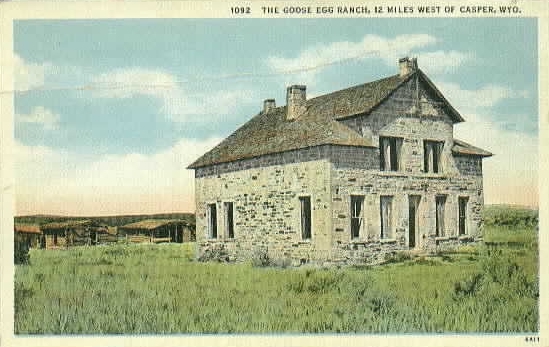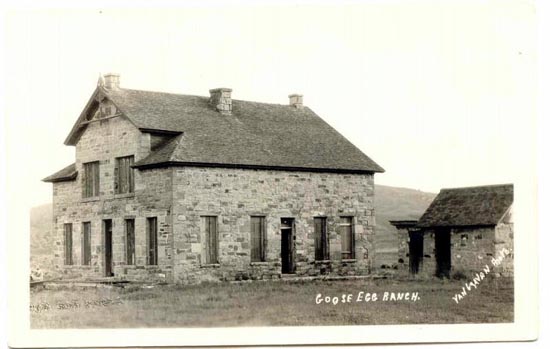|

Bessemer Bend, 1981
Photo courtesy Library of Congress, Prints and Photographs Division
To the east of the Pathfinder Dam, near the confluence of the North Platte with Poison
Spider Creek is Bessemer Bend also known as "Red Buttes." In November 1812 near
Bessemer Bend, the Astorians, under Robert Stuart constructed the first
cabin in Wyoming. Bessemer Bend provided emigrants on the Oregon Trail
an easy location to ford the river and thus avoid the tolls on the Mormon Ferry at Casper.
In 1877, Gilbert A. Searight (1834-1906) established the Goose Egg ranch on the
north bank of the river near the Bend. To stock the ranch, 14,000 head were trailed from
Texas in 1877, another 13,000 in 1878, and 16,000 from Oregon in 1879. The house
was designed to be able to withstand an Indian attack. It was, however, never attacked.

Goose Egg Ranch
The ranch house was
torn down in 1960. The Goose Egg was featured in Owen Wister's The Virginian. The Goose Egg received its
name when several cowboys found a goose nest with eggs and took the eggs to the cook who bore the name
"Old Over Slope". The eggs gave Gilbert Searight insiration for the brand which would be
easy to make and apply. The oval Goose Egg brand was primarily used on horses. Cattle generally
received the Flying E brand. Old Over Slope received his name as a result of his ears being lost to
frost bite giving him an unusual appearance.

Goose Egg Ranch
The Searight Cattle Company was capitalized at $1,500,000, and had
interests from Oregon to Nebraska. In 1885 and 1886, the Company sold potions of the Goose Egg to
J.M. Carey and Brother and other protions to the Swan Land and Cattle Co. The Fort Worth Daily
Gasette January 3, 1887, estimated the losses on the sale to be "several hundred thousand
dollars." The New York Times on the same date was more circumspect reporting that the sale was
"not without considerable shrinkage."

Distant view of Bessemer, Wyoming, 1892.
Nearby in 1888, the town of Bessemer was established consisting of 49 city blocks. Its developers
had high hopes that it would become the county seat for newly formed Natrona County. It was therefore dubbed
"The Queen City of the West." Because of its
central location within the territory, they also believed that it would become the eventual capital of the state replacing the temporary capital in
Cheyenne. Cheyenne is, "technically speaking," still the temporary capital. The plat of
Bessemer reserved space for the
hoped-for capitol building. Its hopes were soon dashed with the formation of Casper. In the election to determine whether
Casper or Bessemer would become the county seat, Bessemer received 731 vots and Casper353; that is, until someone noticed that the
total number of votes cast in the Bessemer pricinct was greater than its total population. All votes in the
Bessemer precinct were therefore disqualified and Casper was declared the winner 353 votes to Bessemer's 64.
By 1895, Casper had a population of 544 and Bessemer a population of 64.

Post Office, Bessemer, Wyoming, 1892.
At its height, in addition to the post office, Bessemer had a hotel, the Searight House; a newspaper,
the Bessemer Journal; and served as the headquarters for the Casper-Rongis Stage Line, owned by William Clark and Son.
The stage line had daily service to Lander and twice daily service to Casper. Clark also engaged in ranching near Natrona, 24 miles west
of Casper. Natrona today consists of little more than a combination gas station and bar.
Next Page: Casper.
|